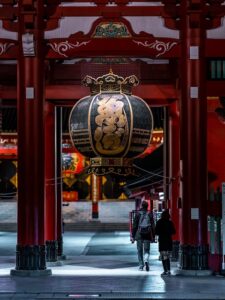【神道と仏教】
【神仏分離令】が出される明治まで、
神道と仏教は寛容な間がありました。
というよりも、仏教に半ば取り込まれていたと取るのが本当かもしれません。
仏教には、日本に来るまでも、さまざまな異国の神々を取り込んできた実績がありますから。
例えば、
 八幡大神=応神天皇を中心とする神様ですが、
八幡大神=応神天皇を中心とする神様ですが、
菩薩号を受けて、八幡大菩薩と【仏より人間に近い役割】を与えられています。
 東照大権現=徳川家康 ですが、
東照大権現=徳川家康 ですが、
この権現【仏が神に化身した姿】を表しています。
神道は【八百万の神】であるため、
仏教の神様たちも【八百万神々の中の神】。
仏教には、【神も解脱に至るもの】として
あらゆる国の神々を抱一する寛容さがあります。
そういう、宗教観の中で、共存共栄していきました。
そして、神道も仏教の影響を濃くしていきました。
神社を巡ると、仏教に関するものが見受けられることも多いです。本殿の外脇の廊下のようなところは
お経を読むところとして作られています。
これを日本では「習合」といって
融合したさまを表しています。

Shinto and Buddhism
Until the Shinbutsu Bunri (Separation of Shinto and Buddhism) was issued in the Meiji era, there was a tolerant relationship between Shinto and Buddhism.
Rather, it might be more accurate to say that Shinto was somewhat absorbed by Buddhism.
Buddhism has a track record of incorporating various foreign gods even before it came to Japan.
For example, Hachiman Daishin, centered around Emperor Ojin, is a god who has received the title of Bodhisattva and has been given a role closer to humans than Buddha.
Toshogu Daigongen = Tokugawa Ieyasu, this Gongen represents the form of Buddha incarnated as a god.
Since Shinto is a religion of “eight million gods”, the gods of Buddhism are also “gods among the eight million gods”.
Buddhism has a tolerance to embrace the gods of all countries as “even gods can attain enlightenment”.
In such a religious view, they coexisted and prospered. And Shinto also heavily influenced Buddhism.
When you visit a Shinto shrine, you often see things related to Buddhism. The corridor-like place on the outside of the main hall is made as a place to read sutras. This is called “syncretism” in Japan, and it represents the form of fusion.
|
|


![[商品価格に関しましては、リンクが作成された時点と現時点で情報が変更されている場合がございます。] [商品価格に関しましては、リンクが作成された時点と現時点で情報が変更されている場合がございます。]](https://hbb.afl.rakuten.co.jp/hgb/3a45ce42.1cdd25ca.3a45ce43.f7ebf2c1/?me_id=1314543&item_id=10001573&pc=https%3A%2F%2Fthumbnail.image.rakuten.co.jp%2F%400_mall%2F4ge3%2Fcabinet%2Fnihonminyo3%2Fimgrc0096690190.jpg%3F_ex%3D240x240&s=240x240&t=picttext)



コメント